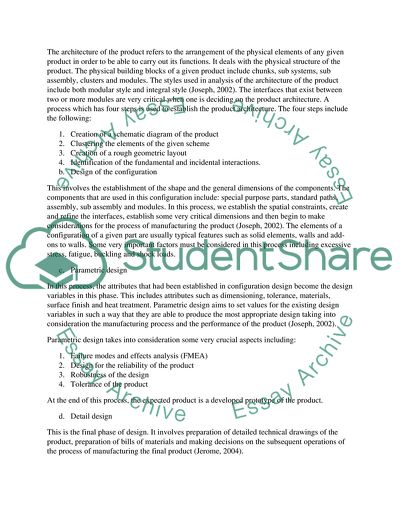Cite this document
(Applications of Supportive Technologies for Design and Product Coursework Example | Topics and Well Written Essays - 2500 words, n.d.)
Applications of Supportive Technologies for Design and Product Coursework Example | Topics and Well Written Essays - 2500 words. https://studentshare.org/engineering-and-construction/1854563-applications-of-supportive-technologies-for-design-and-product-development-dpd-including-cadcamcnc-cae-reverse-engineering-rapid-prototyping-and-manufacturing
Applications of Supportive Technologies for Design and Product Coursework Example | Topics and Well Written Essays - 2500 words. https://studentshare.org/engineering-and-construction/1854563-applications-of-supportive-technologies-for-design-and-product-development-dpd-including-cadcamcnc-cae-reverse-engineering-rapid-prototyping-and-manufacturing
(Applications of Supportive Technologies for Design and Product Coursework Example | Topics and Well Written Essays - 2500 Words)
Applications of Supportive Technologies for Design and Product Coursework Example | Topics and Well Written Essays - 2500 Words. https://studentshare.org/engineering-and-construction/1854563-applications-of-supportive-technologies-for-design-and-product-development-dpd-including-cadcamcnc-cae-reverse-engineering-rapid-prototyping-and-manufacturing.
Applications of Supportive Technologies for Design and Product Coursework Example | Topics and Well Written Essays - 2500 Words. https://studentshare.org/engineering-and-construction/1854563-applications-of-supportive-technologies-for-design-and-product-development-dpd-including-cadcamcnc-cae-reverse-engineering-rapid-prototyping-and-manufacturing.
“Applications of Supportive Technologies for Design and Product Coursework Example | Topics and Well Written Essays - 2500 Words”. https://studentshare.org/engineering-and-construction/1854563-applications-of-supportive-technologies-for-design-and-product-development-dpd-including-cadcamcnc-cae-reverse-engineering-rapid-prototyping-and-manufacturing.


